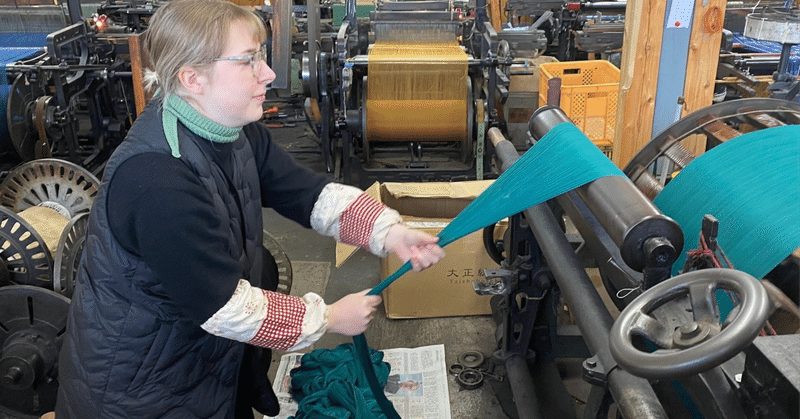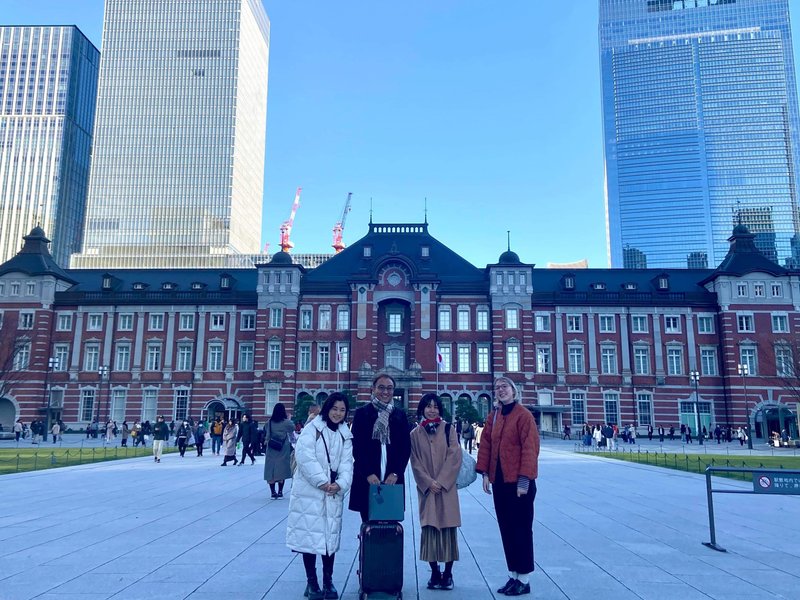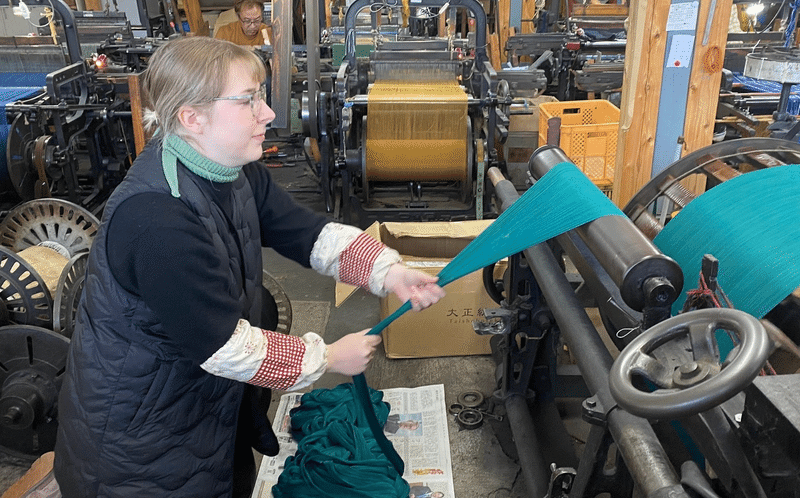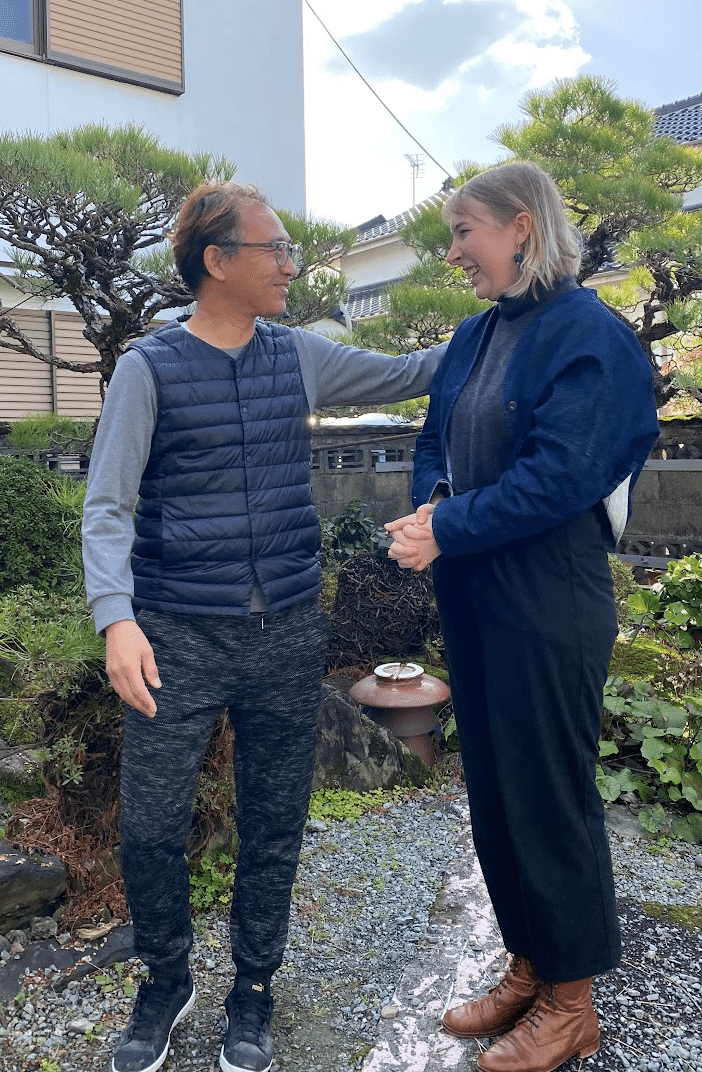
インターン from Germany
Vera Brackloは、昨年の9月に東京藝術大学への短期留学が決定した時点で、その後、、2月〜3月に下川織物でのインターンの申し入れをしてきました。3年前に同じ大学から東京藝術大学へ短期留学し、下川織物へインターンシップで滞在し久留米絣を学んだナディアがいましたが、彼女からも話を聞いて下川織物へのインターンシップを強く決心したようです。現在、下川織物は、職人の世代交代の時期に差し掛かっており工場も人手不足の状況でしたので、Veraは、より実践的に工場内の作業を多く学ぶことができたのではと思います。彼女の情熱は素晴らしく、貪欲に学ぶ姿勢は尊敬に値します。まだまだ学び足りないと近い将来、日本を訪れることを心より歓迎したいと思います。

インターンを終える2月18日の少し前に、彼女に振り返りのインタビューをしました。テキストでまとめてもらいましたので、英文と和訳(Google翻訳)でご紹介いたします。
Self introduction:
My name is Vera Bracklo and I am a master student in the field Conceptual Textile at Burg Giebichenstein in Halle Germany. Before starting my internship at Shimogawa orimono I studied as an exchange student for one semester at Tokyo University of the Arts in the field textile arts.
From early childhood on I was in close contact with Japanese culture and artifacts in my extended family environment. The high quality and sustainability of Japanese craftsmanship as well as its appreciation, care and repair of old and cherished pieces have shaped my own quality standards very much. I had always adored its timelessness, sturdiness, functionality and simplicity. To learn how to select, preserve and adapt the old techniques and objects for the future has been a wish I had since I have studied as an exchange student at Hiroshima City University in 2019.
During my time in Hiroshima my interest and passion for traditional Japanese craftmanship grew and grew. My time there shaped me deeply as an artist and designer. Especially the mindfulness so fundamental to Japanese craftmanship had a great impact on me.
Due to the Covid 19 pandemic I could only attend one semester at Hiroshima City University in person. Although my time in Japan was cut short, the country has had a great and lasting impact on me. I decided to return once more and resume my time in Japan with a deep dive into Japanese textile craft and gather as much knowledge as I can during my 6 months here.

Tokyo University of the Arts
During my studies at Tokyo University of the Arts I concentrated on learning about the traditional textile Techniques Katazome, Bingata and Yuzen.
In preparation to my internship at Shimogawa Orimono I also created a Kasuri textile during my time there. It already showed me how time consuming the Kasuri process can be.
Either one of the crafts I learned is deeply detailed and uses specific and well thought out techniques and cannot be explained in just a few sentences. They all stem from a long tradition and years of experience. Something else I have noticed during my classes is how connected traditional textile practices are to environmental changes. Most of the recipes we used differed according to the season or level of humidity and done in a traditional way used local resources.
This also is the case in the making of Kurume Kasuri at Shimogawa orimono, as the threads will dry faster when hung outside in the sun and the tied yarn called Kukuri is usually loosened on an open field.
Textile (as well as other crafts) culture in Japan is also very special as every region has their own local textile/craft and connected tradition.
During my time in Tokyo I had the chance to meet many talented craftspeople from all over Japan and my conversations with them as well as their passion for their crafts truly inspired me. After I had learned so much in these past months, I was looking forward to my internship in Yame to really experience how Kurume Kasuri is made.

Kurume Kasuri:
Before I came to Japan, I already knew I wanted to gather hands on experience next to my time at Tokyo University of the Arts. I had been drawn to the clear, but at the same time slightly blurred patterns of Kurume Kasuri. Every fabric is unique due to the Kasuri threads moving in a different (but controlled) way every time. This thought excited me as well. It was also important for me to truly experience the daily hard work it takes to create a textile as it is something vastly different from studying about it at university.
I am very thankful, that I was given the chance to learn more about the Kurume Kasuri process these past weeks and I will always keep my time here as a precious memory.
I was greeted with such an openness and kindness by everyone at Shimogawa orimono and my time here went by so fast. I could really sense what it means to be a 3rd generation family business and how much it is part of what Shimogawa orimono is today.
It takes 30 steps and about 3 months to create a Kurume Kasuri textile. These 30 steps involve quite a lot of manual labor, precision and skill. I was able to observe most of them and it became quite evident to me that it takes lots of practice to master just one of the steps involved in the making of Kurume Kasuri. During the process every single thread has been touched multiple times by multiple people along the way. The threads have been pulled, tied, soaked, stretched, dried, washed, divided and threaded over several weeks. To me each fabric is even more special now that I know all the people that are behind its creation.
Shimogawa san is also a very open minded and future oriented craftsman. Next to being open to collaborations with artists and their new ideas, he has welcomed me like others before me in his workshop and shared his knowledge kindly with those who are passionate about textiles as well. By teaching the new generations I believe that traditional techniques like Kurume Kasuri will remain and even flourish as we reevaluate our connection to textiles and our environment.
During my time in Yame I could already sense how his work has made Shimogawa orimono an internationally known and sought out partner by various companies, designers or artists. It is a welcome space for likeminded people from all over the world and his workshop feels like a space of endless possibilities while keeping the tradition alive. My time with him also made me realize how important community is. Shimogawa san works together with many different partners, that are contributing to the creation but also continuation of Kurume Kasuri as well. It is something we all should keep in mind, as in a community we can truly support each other and work together on a common goal.

Future
I am sure this will not be my last time in Japan. For now, I will return to Germany to finish my master degree, but I am already hoping to return for a research trip afterwards. Japan has such a rich Textile culture to offer, and I am not done learning more about it yet. Many Japanese Techniques need time and can’t be studied in just a few weeks so I plan to return with more time on my hands. A friend of Shimogawa san has told me in a conversation: You can read about it, but you have to come here to really understand it. Something I also have experienced during my time here. Until I return, I also want to work more on my Japanese skills to connect with craftspeople without the language barrier that inevitably comes when being in another country and working together.
In the future I would like to realize projects between Germany and Japan and share what I have learned here with as many people as I can. It is a truly special feeling to see how much work, but also well-kept tradition is behind this textile and how much it mirrors the people behind its creation. In my future I want to keep working in a field that supports local craftspeople in Japan as well as Germany, to protect the knowledge that has been gathered and handed over for many years. Ideally, I would like to keep in touch and start collaborations with the people I have met in Japan and establish even more connections in the future.
For now, I will leave Japan with a rich heart and good memories in mind as well as a lot of knowledge I have gathered along the way.
At last, I want to thank Shimogawa san and his family as well as everyone involved with Shimogawa orimono for taking me in and teaching me so patiently about Kurume Kasuri. The past month has been truly special to me. Hontoni arigato gozaimasu.

私の名前はヴェラ・ブラクロで、私はハレ、ドイツのブルク・ギービヒェンシュタインで概念的なテキスタイルの修士課程に在籍しています。下川織物でのインターンシップを始める前に、東京芸術大学でテキスタイルアートの分野で1学期間の交換留学生として学びました。
私は幼少期から日本の文化や工芸品と密接な関わりがありました。日本の職人技術の高さや持続可能性、そして古くて大切なものへの感謝と手入れが、私自身の品質基準を大いに形作ってきました。その永遠性、丈夫さ、機能性、シンプリシティには常に感銘を受けてきました。古い技術やオブジェクトを選択し、保存し、未来のために適応させる方法を学ぶことは、2019年に広島市立大学で交換留学生として学んで以来の願いでした。
広島での時間を通じて、私の日本の伝統的な職人技術への興味と情熱はますます深まりました。そこでの時間は私を芸術家とデザイナーとして深く形作りました。特に、日本の職人技術に不可欠なマインドフルネスが私に大きな影響を与えました。
Covid-19パンデミックのため、私は広島市立大学で対面授業を1学期しか受けられませんでした。日本での滞在時間は短かったですが、その国は私に大きな、そして持続的な影響を与えました。私はもう一度日本に戻り、ここでの6ヶ月間を日本のテキスタイルクラフトに深く没頭し、できるだけ多くの知識を得ることを決意しました。

東京芸術大学
東京芸術大学での学業では、私は伝統的なテキスタイル技法である型染め(Katazome)、紅型(Bingata)、友禅(Yuzen)に焦点を当てました。
下川織物でのインターンシップの準備として、私はそこでの時間を利用して絣(かすり)のテキスタイルを制作しました。それにより、絣のプロセスがどれほど時間を要するかがわかりました。学んだいずれの職種も非常に詳細で、特定のよく考え抜かれた技法を使用しており、それを簡単に説明することはできません。これらはすべて長い伝統と多くの経験に基づいています。授業中に気づいた別のことは、伝統的なテキスタイルの実践が環境の変化と密接に結びついていることです。私たちが使用したほとんどのレシピは季節や湿度のレベルに応じて異なり、伝統的な方法で行われ、地元の資源を使用しています。これはまた、下川織物での久留米絣の製作にも当てはまります。糸は外で太陽に干されるとより速く乾燥し、結ばれた糸(くくり)は通常、広場で緩められます。
日本のテキスタイル(および他の工芸品)文化は、各地域が独自の地元のテキスタイル/工芸と結びついた伝統を持っているため、非常に特別です。東京での滞在中、私は日本中から多くの才能ある職人と出会う機会があり、彼らとの対話や彼らの職業への情熱が私を本当に感動させました。これらの数か月で多くを学び取った後、八女でのインターンシップを楽しみにしており、久留米絣の製造過程を実際に体験することができることを楽しみにしていました。

久留米絣:
日本に来る前から、東京芸術大学での時間の傍ら、実地経験を積みたいと思っていました。久留米絣のはっきりとしたが、同時にわずかにぼかされた模様に引かれていました。各生地は、絣の糸が毎回異なる(しかし制御された)方法で動くため、ユニークです。この考えは私を興奮させました。また、大学で学ぶこととは大きく異なる、織物を作るために日々かかる実際の労働を真に経験することが私にとって重要でした。
これらの過去の数週間で久留米絣のプロセスについて学ぶ機会をいただけて非常に感謝しています。ここでの時間はいつまでも宝として心に留めておくでしょう。下川織物の皆さんから受けた開かれた心と親切に、私はあっという間に過ぎていった時間を感じました。私は本当に、3代目の家族経営がどれほどShimogawa Orimonoの一部であるかを感じることができました。
久留米絣の織物を作るには30の工程と約3か月がかかります。これら30の工程にはかなりの手作業、精密さ、技術が含まれています。私はほとんどの工程を観察することができ、久留米絣の製作に関与する工程の一つをマスターするには多くの練習が必要であることが非常に明白になりました。プロセス中、各糸は途中で複数回、複数の人によって触れられています。糸は引かれ、結ばれ、浸され、伸ばされ、乾燥させられ、洗われ、分けられ、数週間かけて糸に通されます。私にとって、各生地はその創造の背後にいるすべての人々を知る今、さらに特別です。
下川さんは非常にオープンで未来志向の職人でもあります。アーティストや彼らの新しいアイデアとのコラボレーションにも開かれており、彼は彼の工房で私を含む他の多くの人たちを歓迎し、熱心にテキスタイルに情熱を抱く者たちと彼の知識を親切に共有しています。新しい世代に教えることで、私は久留米絣のような伝統的な技法がテキスタイルや環境とのつながりを見直す中で存続し、さらに繁栄すると信じています。
八女での滞在中、下川織物の仕事がいかにしてShimogawa Orimonoを国際的に知られ、様々な企業、デザイナー、アーティストにとって求められるパートナーにしてきたかを感じることができました。それは世界中からの志を同じくする人々にとって歓迎される空間であり、彼の工房は伝統を守りながらも無限の可能性を秘めた場所のように感じられます。彼と過ごした時間はまた、コミュニティがいかに重要かを理解させてくれました。下川さんはさまざまなパートナーと協力しており、それが久留米絣の創造だけでなく継続に貢献しています。これは私たち全員が心に留めておくべきことであり、コミュニティでは本当にお互いをサポートし、共通の目標に向かって協力できるのです。

将来
確信していますが、これは私が日本を訪れる最後の機会ではないでしょう。今のところは、修士課程を終えるためにドイツに戻りますが、その後に研究旅行のために戻りたいと思っています。日本は非常に豊かなテキスタイル文化を提供しており、私はまだそのことを学び尽くしていません。多くの日本の技法は時間がかかり、数週間では学べないため、より多くの時間をかけて戻る計画です。下川さんの友人が会話の中で教えてくれた言葉がありました。「読むことはできるけれども、本当に理解するにはここに来なければなりません。」これも私がここでの時間を通じて経験したことです。戻るまでに、言語の障壁を超えて職人たちとつながるために、日本語のスキルをもっと向上させたいと思っています。
将来的には、ドイツと日本の間でプロジェクトを実現し、ここで学んだことをできるだけ多くの人々と共有したいと考えています。このテキスタイルの背後にはどれだけの作業があり、同時によく保たれている伝統があるかを見ることは、本当に特別な感覚です。将来にわたり、日本とドイツの地元の職人をサポートし、何十年にもわたり蓄積され、受け継がれてきた知識を保護する分野で働き続けたいと思っています。理想的には、日本で出会った人々と連絡を取り合い、将来さらなるつながりを築きたいと考えています。
今のところ、私は豊かな心と良い思い出、そしてこれまでに得た多くの知識を胸に、日本を離れることになります。
最後に、下川さんと彼の家族、そして下川織物に関わるすべての方々に、久留米絣について丁寧に教えていただき、受け入れていただいたことに感謝いたします。過去の数か月は私にとって本当に特別なものでした。本当にありがとうございます。

久留米絣織元 下川織物
E-MAIL info@oriyasan.com
instagram http://instagram.com/shimogawakyozo/
facebook https://www.facebook.com/shimogawaorimono
Twitter @kasuritter
Tumblr kyozoshimogawa
YouTube https://www.youtube.com/channel/UCOZennIqkscFGNJLwnTOyKg
いただいたサポートは、職人の育成など有意義に使わせていただきます。
